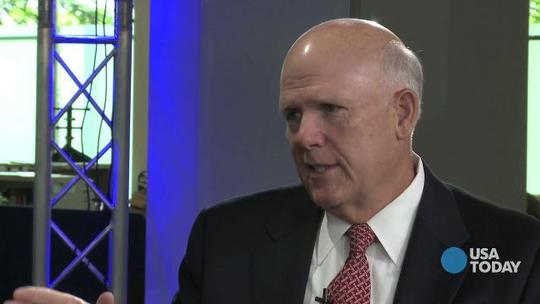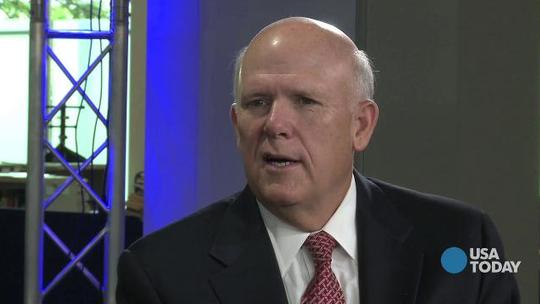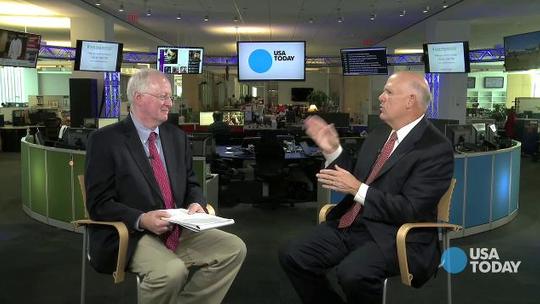GM CEO Dan Akerson's top 9 leadership lessons
Daniel Akerson, electrical engineer and finance man by training, Naval officer by decree, executive by design, and, since 2010, General Motors CEO almost by default.
Akerson, 64, spent years atop telecommunications and technical companies, as well as running a big private investment fund, and he believes those are the places he absorbed the management lessons he's taken to GM.
The most important:
"Fundamentally, no kidding, it's all about leadership. I don't think you have to be a subject-matter expert," he said in an interview with USA TODAY. "Complex organizations have many common challenges."
Akerson took the top job at GM three years ago next month, and on his watch, the once-wrecked automaker has bloomed. Outsiders aren't sure how much of that is Akerson's direct doing and how much is a combination of a recovering economy and an array of good products, designed before he got there and launched while he's been chief.
He was greeted in Detroit by a raspberry. "Not a car guy," was the derisive verdict. In fact, "Who is this guy," was the louder chant.
Fortunate, then, that leadership skills are portable.
"Leadership skills can carry you from equities management to corporate jobs. Leadership is transferable," says Alan Merten, president emeritus of George Mason University, author and expert on leadership and management. Akerson is "a good example of someone who took his knowledge and leadership skills with him wherever he went," according to Merten.

It seems so. With the unknown "not-a-car- guy" driving, GM has begun to field impressive products and has a remarkable suite of top executives.
And not least, the automaker is reporting record profits.
"So, here we are four years out of bankruptcy and we've made $25 billion (before taxes and interest). I think that's more than the company's ever made in a four-year period," Akerson said.
It takes three or four years to develop a vehicle, so only now will Akerson's automotive acumen begin to show. Still, he's had plenty of time to exercise his management and leadership skills — and earn a report card.
"I think he gets a near straight-A assessment. There have been a few missteps, like the (mediocre sales of Chevrolet's) Malibu and the initial sales numbers from the Volt, but even these issues have been quickly addressed, something the old GM never bothered with," says Karl Brauer, senior analyst at Kelley Blue Book, auto researcher.
Under Akerson, the Malibu's getting a new interior, quickly, because that's seen as its weak point, and the extended-range Volt electric car has gotten price cuts to spur sales.

Those examples of promptly addressing problems amount to a change in attitude at GM.
Akerson is "a strong believer in management by walking around. Everywhere he's been you see pictures of him with employees. He's a reminder that management is a contact sport," Merten says.
Not all of Akerson's success is his doing, in the view of some.
"Put me in the category of being doubtful. He's blessed with a burgeoning market and he's blessed by having a line of products designed, primarily, long before he arrived," says Gerald Meyers, crisis-management consultant, and professor at the University of Michigan.
"You have to give him credit for the accomplishment. But now comes the hard part," says Meyers, who was CEO of American Motors from 1977 to 1982, when it partnered financially with France's Renault to stay alive.
Also wary is Michelle Krebs, a senior analyst at Edmunds.com, a car-research site. She gives Akerson a "B" overall.
Akerson joined GM's board in 2009 as the company went through its bankruptcy reorganization. He became CEO Sept. 1, 2010, and led GM's 2010 return to the stock market — at the time the largest initial public offering in U.S. history.

Here are Akerson's executive-level lessons from squiring GM after the crucible of bankruptcy reorganization. He believes that what's been learned will help get through "the hard part" that Meyers foresees. His way:
• Make goals clear. In GM's case, the Chapter 11 reorganization allowed the automaker to cut costs by eliminating brands and workers, giving it some momentum. But "you can't live on a crisis mode," Akerson said, and must return a troubled company to more normal operations. To make that happen, he said, a CEO's role is "to articulate that vision, and a strategy, what you want to accomplish."
• Overhauling top management ruffled some feathers, but created more focused leadership.
Says Meyers: "Almost all top, key people are new and aggressive, intelligent, articulate. That's to his (Akerson's) credit."
Meyers says that Akerson "pulled no punches in changing the people who, in his mind, needed to be changed."
• Insist that "good enough" just isn't. Akerson: "I was told one time when I asked about quality: 'It's as good as anyone else's.' Well, when I was in school and if I'd have come home and told my dad, that I did as well as everybody else — a 'C' didn't cut it. What are we doing to improve?"
He once walked out of a Cadillac meeting because what he considered a modern telecommunications/connectivity system was being discussed for several years down the road instead of for immediate use. And when engineers and product planners tell him some feature that he thinks is necessary might be too expensive, he's likely to say, "Figure it out. No more excuses."

• "Question the status quo," he insists. Past practices "can be flawed," no matter how tightly held they are within a company. "You have to be able to define reality," Akerson says.
In this case, that meant axing some of what die-hards thought made up the core of GM, such as investing in new powertrains even though they might be too expensive, might not work in a variety of vehicles, or might not be sufficiently different from those already in production.
• Be quick to capitaIize on good ideas. From his time in the telecommunications business, he notes that it's often smaller operations, not the giants such as AT&T, that capitalize on fresh technology and turn it into profit-making enterprises.
"We are the most prolific patenter in the automotive industry, but we weren't converting that to commercial" use, he said. At a GM management meeting he asked for examples of "three or four things that are in the cars today that we invented in the last 10 years. There weren't any."
•Tackle the back room, the information technology and accounting methods that sound boring but are the foundation of how modern companies operate. "Reform some of (the) systemic issues that cause problems," is how he puts it.
• If it's not working, quit doing it. "We're not going to sustain operations in the business that continually lose."
• Don't let up. "You have to be a patient and constructive critic," he says.
• Don't get distracted from the main reason you're there.
Akerson: "Fundamentally, I've got to run a business that's going to turn profits."









